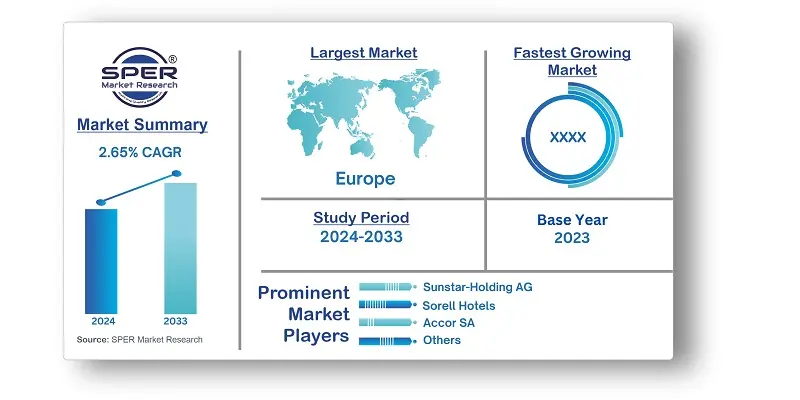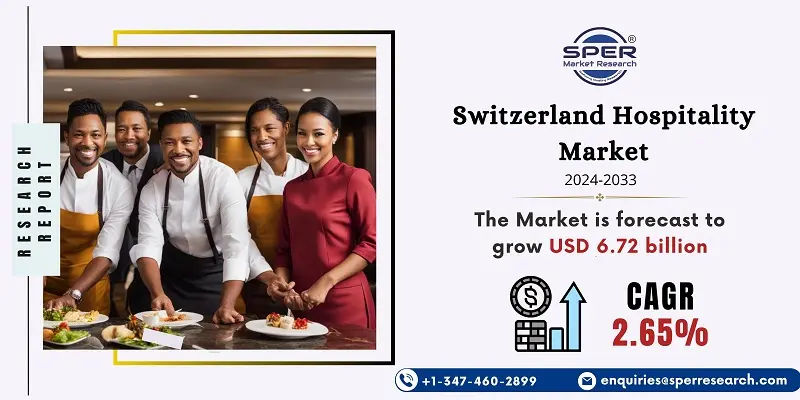
Switzerland Hospitality Market Growth, Size, Trends, Demand, Share, Revenue and Future Outlook
Switzerland Hospitality Market Size- By Type, By Segment- Regional Outlook, Competitive Strategies and Segment Forecast to 2033
| Published: Jul-2024 | Report ID: TRAT2403 | Pages: 1 - 105 | Formats*: |
| Category : Travel & Tourism | |||
- May 2023: IHG and Tristar GmbH announced an extension of their Multiple Development Agreement in Northern Europe. According to the deal, the cooperation will expand to 60 hotels with IHG Hotels & Resorts by 2035, with new locations planned in Germany, Austria, Switzerland, Poland and Italy.
- March 2023: Radisson Hotel Group enters Switzerland's serviced flat sector with the May 2023 opening of the Radisson Hotel & Suites Zurich. The Radisson Hotel & Suites Zurich is located in the newly developed Opfikon neighbourhood, Glattpark. The region is ideally placed between Zurich's city centre and the airport.


| Report Metric | Details |
| Market size available for years | 2020-2033 |
| Base year considered | 2023 |
| Forecast period | 2024-2033 |
| Segments covered | By Type, By Segment |
| Regions covered | Eastern Region, Southern Region, Northern Region, Western Region |
| Companies Covered | Accor SA, Sorell Hotels, Sunstar-Holding AG, Best Western International Inc, InterContinental Hotel Group, Marriott International Inc, Radisson Hotel Group, Hotels by Fassbind, Boas-Yakhin Holding SA, H Hotels. |
- Leisure Tourists
- Luxury Travelers
- Adventure and Sports Enthusiasts
- Business Travelers
- Health and Wellness Tourists
- Family Travelers
- Cultural and Heritage Tourists
- Eco-Conscious Travelers
| By Type: |
|
| By Segment: |
|
- Switzerland Hospitality Market Size (FY’2024-FY’2033)
- Overview of Switzerland Hospitality Market
- Segmentation of Switzerland Hospitality Market By Type (Chain Hotels, Independent Hotels)
- Segmentation of Switzerland Hospitality Market By Segment (Service Apartments, Budget and Economy Hotels, Mid and Upper Mid-scale Hotels, Luxury Hotels)
- Statistical Snap of Switzerland Hospitality Market
- Expansion Analysis of Switzerland Hospitality Market
- Problems and Obstacles in Switzerland Hospitality Market
- Competitive Landscape in the Switzerland Hospitality Market
- Impact of COVID-19 and Demonetization on Switzerland Hospitality Market
- Details on Current Investment in Switzerland Hospitality Market
- Competitive Analysis of Switzerland Hospitality Market
- Prominent Players in the Switzerland Hospitality Market
- SWOT Analysis of Switzerland Hospitality Market
- Switzerland Hospitality Market Future Outlook and Projections (FY’2024-FY’2033)
- Recommendations from Analyst
1.1. Scope of the report1.2. Market segment analysis
2.1. Research data source
2.1.1. Secondary Data2.1.2. Primary Data2.1.3. SPER’s internal database2.1.4. Premium insight from KOL’s
2.2. Market size estimation
2.2.1. Top-down and Bottom-up approach
2.3. Data triangulation
4.1. Driver, Restraint, Opportunity and Challenges analysis
4.1.1. Drivers4.1.2. Restraints4.1.3. Opportunities4.1.4. Challenges
4.2. COVID-19 Impacts of the Switzerland Hospitality Market.
5.1. SWOT Analysis
5.1.1. Strengths5.1.2. Weaknesses5.1.3. Opportunities5.1.4. Threats
5.2. PESTEL Analysis
5.2.1. Political Landscape5.2.2. Economic Landscape5.2.3. Social Landscape5.2.4. Technological Landscape5.2.5. Environmental Landscape5.2.6. Legal Landscape
5.3. PORTER’s Five Forces
5.3.1. Bargaining power of suppliers5.3.2. Bargaining power of buyers5.3.3. Threat of Substitute5.3.4. Threat of new entrant5.3.5. Competitive rivalry
5.4. Heat Map Analysis
6.1. Switzerland Hospitality Market Manufacturing Base Distribution, Sales Area, Product Type6.2. Mergers & Acquisitions, Partnerships, Product Launch, and Collaboration in Switzerland Hospitality Market.
7.1. Switzerland Hospitality Market Size, Share and Forecast, By Type, 2020-20267.2. Switzerland Hospitality Market Size, Share and Forecast, By Type, 2027-20337.3. Chain Hotels7.4. Independent Hotels
8.1. Switzerland Hospitality Market Size, Share and Forecast, By Segment, 2020-20268.2. Switzerland Hospitality Market Size, Share and Forecast, By Segment, 2027-20338.3. Service Apartments8.4. Budget and Economy Hotels8.5. Mid and Upper Mid-scale Hotels8.6. Luxury Hotels
9.1. Switzerland Hospitality Market Size and Market Share
10.1. Switzerland Hospitality Market Size and Market Share By Region (2020-2026)10.2. Switzerland Hospitality Market Size and Market Share By Region (2027-2033)10.3. Eastern Region10.4. Western Region10.5. Southern Region10.6. Northern Region
11.1. Accor SA
11.1.1. Company details11.1.2. Financial outlook11.1.3. Product summary11.1.4. Recent developments
11.2. InterContinental Hotel Group
11.2.1. Company details11.2.2. Financial outlook11.2.3. Product summary11.2.4. Recent developments
11.3. Marriott International Inc
11.3.1. Company details11.3.2. Financial outlook11.3.3. Product summary11.3.4. Recent developments
11.4. Radisson Hotel Group
11.4.1. Company details11.4.2. Financial outlook11.4.3. Product summary11.4.4. Recent developments
11.5. Sorell Hotels
11.5.1. Company details11.5.2. Financial outlook11.5.3. Product summary11.5.4. Recent developments
11.6. Sunstar-Holding AG
11.6.1. Company details11.6.2. Financial outlook11.6.3. Product summary11.6.4. Recent developments
11.7. Best Western International Inc
11.7.1. Company details11.7.2. Financial outlook11.7.3. Product summary11.7.4. Recent developments
11.8. Hotels by Fassbind
11.8.1. Company details11.8.2. Financial outlook11.8.3. Product summary11.8.4. Recent developments
11.9. Boas-Yakhin Holding SA
11.9.1. Company details11.9.2. Financial outlook11.9.3. Product summary11.9.4. Recent developments
11.10. H Hotels
11.10.1. Company details11.10.2. Financial outlook11.10.3. Product summary11.10.4. Recent developments
11.11. Others
SPER Market Research’s methodology uses great emphasis on primary research to ensure that the market intelligence insights are up to date, reliable and accurate. Primary interviews are done with players involved in each phase of a supply chain to analyze the market forecasting. The secondary research method is used to help you fully understand how the future markets and the spending patterns look likes.
The report is based on in-depth qualitative and quantitative analysis of the Product Market. The quantitative analysis involves the application of various projection and sampling techniques. The qualitative analysis involves primary interviews, surveys, and vendor briefings. The data gathered as a result of these processes are validated through experts opinion. Our research methodology entails an ideal mixture of primary and secondary initiatives.



Frequently Asked Questions About This Report
PLACE AN ORDER
Year End Discount
Sample Report
Pre-Purchase Inquiry
NEED CUSTOMIZATION?
Request CustomizationCALL OR EMAIL US
100% Secure Payment






Related Reports
Our Global Clients
Our data-driven insights have influenced the strategy of 200+ reputed companies across the globe.






















